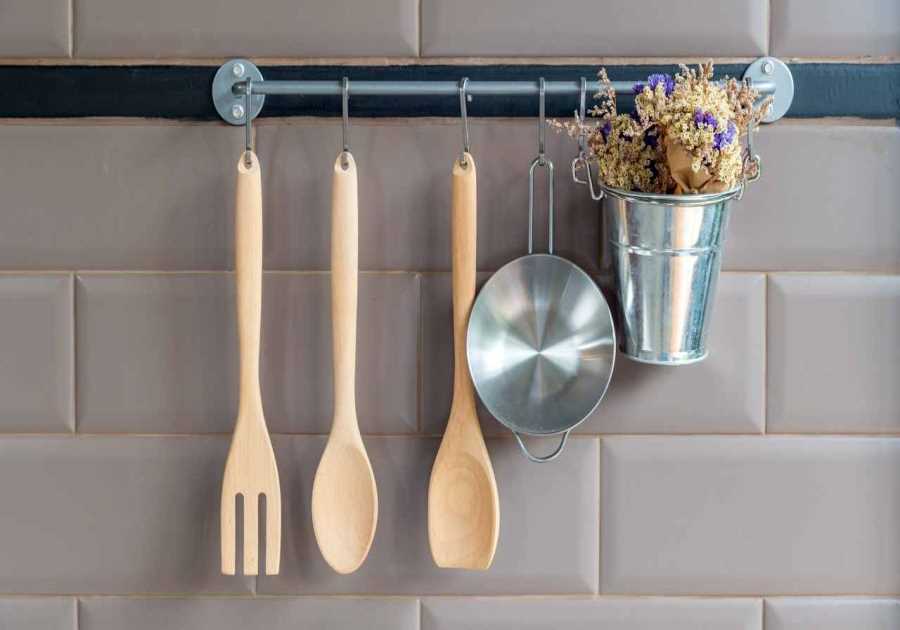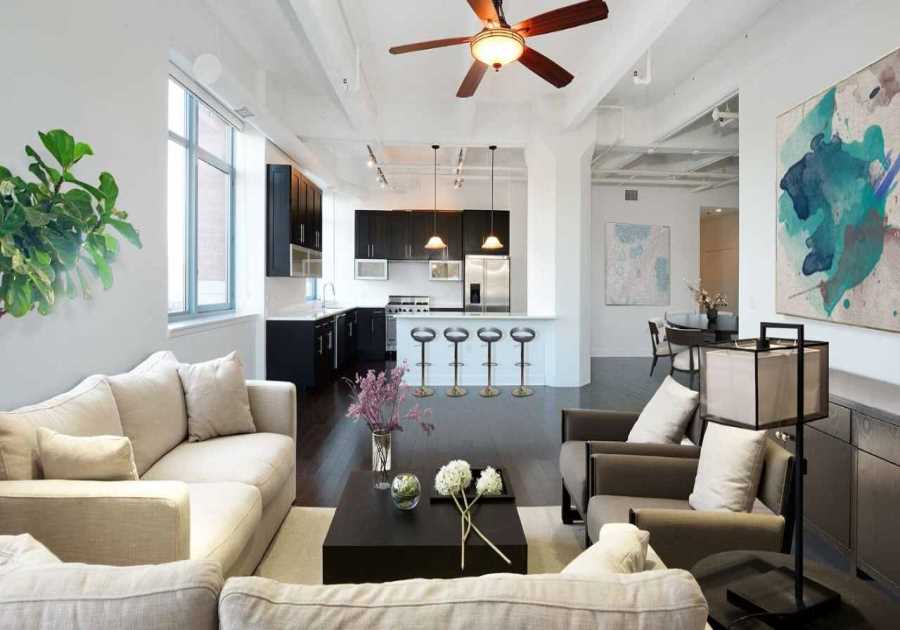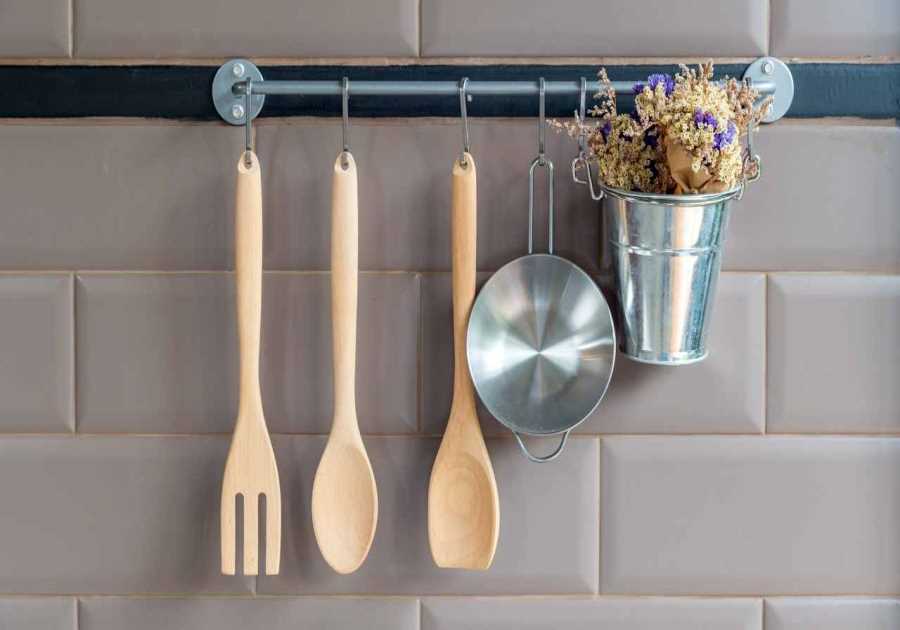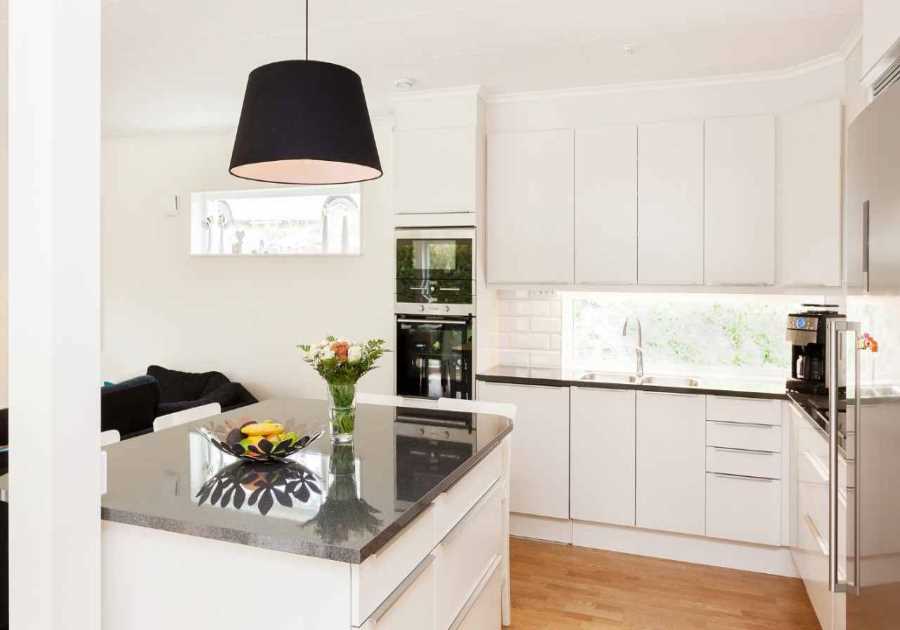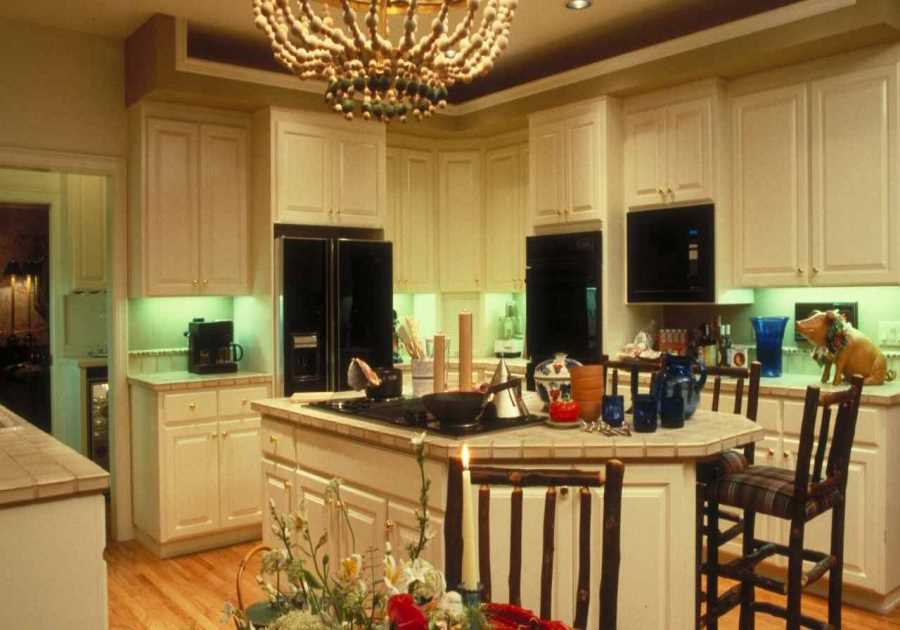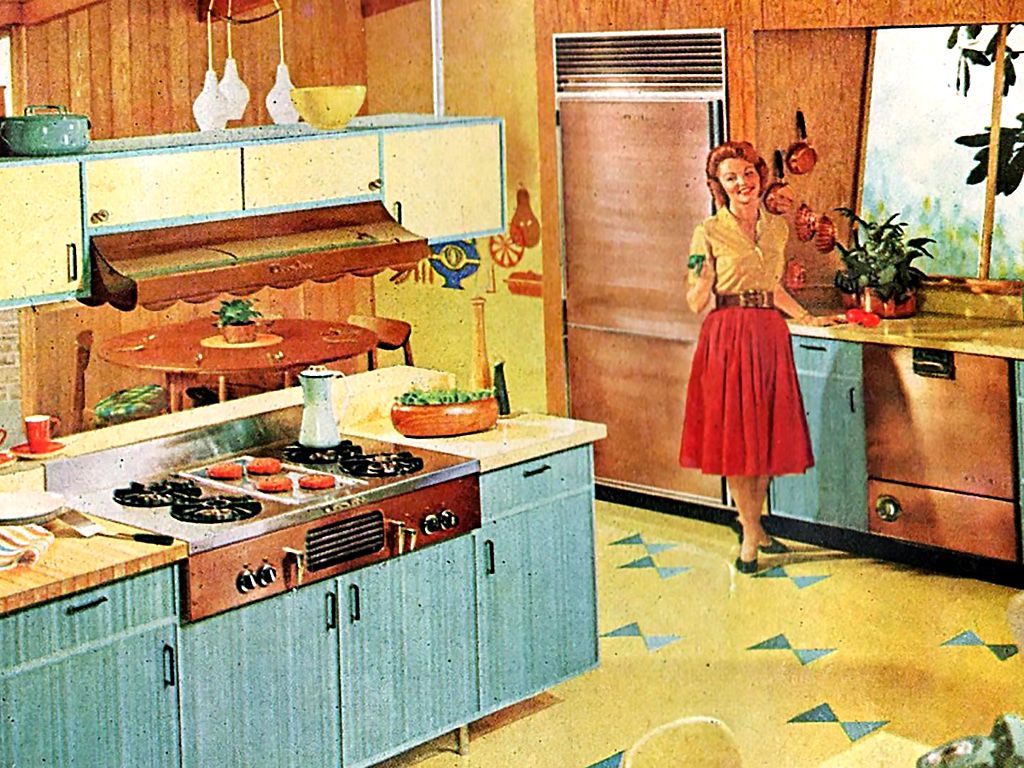
Tour the era-defining designs of vintage American kitchens from the 1950s, '60s and '70s.
Forget everything you know about modern kitchen design because we're taking a trip back to explore the wondrous and often bizarre aesthetics from this era-defining decade.
From pastel hues to psychedelic pops of colour, let's observe the special ingredient which made these classic kitchens so beloved: timeless style.
The 50's saw the introduction of classic appliances with retro-modern designs inspired by jet plane technology and sleek atomic stylings. Washed in oceanic shades of blue and turquoise, this kitchen decor embodies something unique and undeniably attractive – something that, even if it’s not in fashion today, will always bring nostalgia to those who remember them fondly.
But what makes these vintage kitchens truly memorable is their bold use of materials: lush countertops combined with white tile walls, vibrant novelty prints intertwined with hanging plants, and innovative shelving systems clad in wood panelling. We’re left with an aesthetic that goes beyond bloomin' awesome - they are simply sublime!
Meanwhile, the '60s dared us closer to places no kitchen had ever gone before! Eye-popping oranges juxtaposed against sunset pinks or seductive blues combining seamlessly alongside vast splashes of yellow – find yourself at home among interiors' most daring duos! Marrying elegance with avant-garde chicness rarely does such a thing seem appropriate for a living space…until now!
And lastly, there was the 70’s, when vintage met its most opulent destination yet. Glittering accents illuminated dusty corners where warm honey mustards coexisted happily next to deep purple mystery tones - creating a melodic chorus that stayed firmly planted through almost four decades. Here sleek lines blended well with nature while classy wood grain framed aesthetic beauty like never before. Welcome home, indeed!
1950s kitchens were a celebration of vibrant colours
American kitchens during the 1950s celebrated bright colours and innovative materials. From linoleum floors to candy-coloured cabinets, the vibrant style of these kitchens was anything but drab.
In the mid-1950s, designers and architects began to realize the social function of the kitchen. It became a central hub where the entire family could interact. Architects also began to open up floor plans to allow the kitchen to integrate with the rest of the house.
The first models of these open kitchens opened directly into the living room. Housewives could do everything from cooking to cleaning without leaving the kitchen.
Colour coordination was key to a well-functioning kitchen. A '50s kitchen design often featured bright blues, pinks, and yellows. These bold hues were an antidote to the drab and depressing atmosphere of the time.
The nostalgia of classic American kitchen décor from the 1960s.
A decorating revolution was underway in America’s homes – and kitchens were its epicentre. Bold colour schemes, polished accessories, geometric shapes, sleek lines, plus mix-and-match variations infuse renewed energy into kitchen setups while celebrating sustainability and function.
Bright sunshiny yellows married vintage ceramic tile accents with floral wallpaper trim added the perfect pop of colour.
Meanwhile, avocado greens decorated the walls with matching cabinetry for a cohesive vibe. Appliances in shades of pastels such as blues and pinks softened up the kitchen space giving it a charming country feel.
Suburban houses featured custom-built cabinetry and handy island creations where shiny chrome hardware glistened pops of contemporary flair to kitchens everywhere!
Vintage enamel table tops provided stylish cafeterias inspired by 1950s diners from the comfort of one’s homes. Retro styling in this era customized furniture for family living; sofas included clever pullout designs for sleepovers, and storage benches kept messes contained seamlessly invisible out of sight!
Chic cherubs stitched on linens or dotted around accent décor favoured rec room styles that complemented any classic ‘60s kitchen setup. Made-up fun activities like wooden spoons smacked into hands brought playfulness to active mealtime environments. At the same time, black & white stone tiled floors easily contained everyday spills – transforming always full spaces into inviting backdrops highlighting '60′s design elements over natural earth tones throughout!
Today these '60s décor sparks still celebrate traditional values emerging in home interiors across the US - modular furniture paired with natural materials still fit perfectly, embracing timeless looks that bring a retro feel alive!
1970s tile work resurfaced a few years later
In the 1970s, the kitchen showcased various colours, textures and gadgets. This era is best remembered for its colourful appliances, big freezers and kitchen islands. Using these items to their fullest, homemakers could create a feast for family and friends.
The mid-1970s was a whirlwind of change, but some trends from the previous decade continued to come back. Avocado green was one of the more popular colour schemes. Its greenness paired well with a few other earth tones and natural goodies. Aside from its prominent use in the kitchen, the avocado aficionado could also find it in the living room.
Not to be outdone by the avocado, the 1970s was also home to the largest assortment of gadgets. Colourful kitchen appliances paved the way, and even a few inflatable items could find their way into the house.
The 70s saw the birth of many modern kitchens, and the tiles adorned them were a sight for sore eyes. The era also saw the proliferation of psychedelic and colourful tile work, rediscovered in American kitchens a few years later. Interestingly, the same trend was spotted in the bathroom, with ceramic tile aplenty.
A few of these relics were put to good use, and today, it is not uncommon to see a full bathroom tiled in the 70s style. While many may not appreciate the retro look, it is an era full of technological innovation, and many homeowners have taken the opportunity to relive that time in their lives.
1970s tile work resurfaced again
There was a big trend in the 1970s when ceramic tile work was all the rage. It peaked during this period and the designs were bright, colourful and classy. Eventually, the tile work fell out of favour with the introduction of engineered stone slabs. However, many homeowners still enjoy the look of tiles in their kitchens. They have a textured look that can be easily achieved, and the tiles are affordable.
In addition to being durable and easy to clean, and resistant to stains and heat. They are also very easy to install. While they require some daily cleaning, they are inexpensive and non-porous, so you can safely wash them with mild soap and water. To keep them looking great, you must seal them at least once a year to prevent bacteria and mould.
Frequently Asked Questions
How can you design an open-concept kitchen layout?
An easy workflow is the best way organize an open-concept space. This means that appliances should be close to each other. Having these items close together makes cleaning easier. Also, keep all cooking utensils near each other for easy access. Keep food storage close to where you use it. This will make it easy to grab what is needed and then put it away.
Are Kitchen Remodeling Costs Worth it?
Remodelling your kitchen can be a great way to improve the look and feel of your home, but it can also be costly. There are many things to consider when remodeling your kitchen.
There are many factors that you need to consider when deciding whether or not remodeling your kitchen is a good idea. The first is the value of your home. You will need to make sure that the remodel costs are covered in your sale price if you intend on selling your house soon.
You should also consider the cost of the actual remodel. High-end kitchen remodels can run up to $50,000 so make sure you have enough money. The cost of remodeling your kitchen may not be a major concern if you don't plan to sell your house.
Consider how much you will be using your new kitchen. If you entertain often or cook large meals, you'll want to ensure that your new kitchen can accommodate your needs. You might be able manage with a smaller, more affordable remodel if you don't intend to use your kitchen often.
These are some helpful tips to get you started if your not sure where to begin.
- Decide whether you want to build new cabinets or replace existing cabinets. Kitchen remodels can be expensive if you add new cabinets. If you decide to replace all of the cabinets, you will need to take them out before installing new ones.
- Be careful when choosing your colors. The overall look of your kitchen can be affected by the choice of colours. So choose carefully.
- Decide if the flooring needs to be updated. The flooring may not be needed if you plan on selling your house within the next few months. A freshly painted concrete slab can give off a "new" feel.
- Add storage space. Consider adding cabinets, drawers or shelves to increase the usable space in your kitchen.
- Lighting is important. Recessed lights installed above the sink, stove, and refrigerator can brighten dark corners in your kitchen.
- Add Appliances. It can help reduce your energy consumption by replacing your old fridge with one of the newer models. This can increase the resale price of your house.
- Make sure that there are enough outlets. The majority of kitchens only have one or two outlets. This means that your blender, microwave and other appliances won't work in your kitchen.
- Do not forget to look at the water lines. Water pipes are hidden behind walls and floors. Before beginning any work, ensure you check for leaks.
- Reduce clutter. You may already have a cluttered kitchen, so try to organize. Take out anything unnecessary.
- Get estimates from several contractors. Compare prices by square footage, material type (cabinets or stone), as well as the number of windows and doors.
- Financing options are available. Many people finance their kitchen renovations. You can avoid paying interest and make payments.
- It is important to know how long you plan on staying in your house. You should invest more in your kitchen the longer that you are there.
- Keep track of everything. Keep track of everything that happens during the construction process. Use a notebook to record measurements, materials, and construction techniques.
- Plan ahead. Make sure to take the time to draw what you would like to see in your kitchen. This will help you visualize the whole project.
Which pots and pans should be placed in the kitchen's cupboards?
Pots and saucepans should be stored in the cupboard directly above the stove. It makes them easy to find when you need them, and it keeps your kitchen countertops clean and tidy. A pot rack can also be a great investment to keep your pots and saucepans organized and easily accessible.
What are the steps to remodelling a kitchen?
- Plan your kitchen remodel. Decide what you want to change and how much you want to spend.
- Find a contractor. Ask for bids from multiple contractors. Then choose the one that you are most comfortable with.
- Demolition. This is where the fun begins! Take out all the cabinets, countertops, appliances.
- Installation. Installation.
- Final touches. Finishing touches such as paint or new hardware will complete your kitchen remodel.
Statistics
- In large firms, the commission charged by the GC ranges from 15 to 25 percent of the total job cost. (thespruce.com)
- In the Pacific region (Alaska, California, Washington, and Oregon), according to Remodeling Magazine, that same midrange central kitchen remodel jumps to $72,513, and a major upscale kitchen remodels jumps up $11,823 from the national average to $143,333. (hgtv.com)
- Keep 10 to 25 percent of List 2, depending on the budget. (familyhandyman.com)
- Experts also recommend setting aside 20 percent of your budget for surprises, including unpleasant demolition discoveries. One is water damage, the electricity that is not up to code, or other budget-spiking gotchas. (hgtv.com)
- Your most significant cost investment for a kitchen remodel will usually be cabinets, typically comprising 25 percent of your budget. (hgtv.com)
External Links
remodeling.hw.net
homeadvisor.com
- Learn how much it costs to Remodel a Kitchen - Compose: SEO.
- What Does a Kitchen Remodel Do to Increase Your Home's Value? - HomeAdvisor
thespruce.com
houzz.com
- The Habitatilist - Project Photos & Reviews - South Orange, NJ US
- Kitchen Workbook: 8 Element of a Craftsman's Kitchen
How To
How do you select a kitchen remodelling company?
These tips can help you make the right choice when hiring a Kitchen Remodel contractor.
- Ask your friends for feedback on their experiences working with contractors. It's a great way for contractors to receive honest feedback. Ask them about the work quality, professionalism, cleanliness, punctuality, etc. Consider asking them if there were any problems with their contractor. How did they resolve the issues?
- Reach out to several companies to request estimates for your project. Prepare to give a detailed description and why you are hiring someone else. Tell them you're looking for someone who specializes in kitchen remodels. You can also include details about the size of the room, the type of materials used, etc. Tell them exactly what type of finish (i.e. countertops, cabinets and backsplash, flooring). Don't forget to mention anything specific that you would like done during the project. Do you need new appliances? Do you desire a particular style or type of cabinetry Is there a unique feature like a wine refrigerator or built-in microwave oven that you would like included?
- Make sure to verify that the company is covered by worker's compensation and insurance. Look online to determine if the contractor has any trade associations. It is always a good idea to partner with a reputable company.
- Talk to the contractor about your project. Ask them questions about their experience, qualifications, and methods. Ask them how they would approach your project, and what timeline they envisage.
- Get references from previous clients. When hiring a contractor, don't just take his word for it; ask him for referrals. Call the names he recommends from his list of references. Ask them if you can speak with them about their positive experiences working for this contractor.
- Look at reviews left by past customers on sites like Yelp, Angie's List, and Houzz. Many homeowners use these websites to leave reviews after completing projects. Positive reviews will assure you that you get a good job.
- Consider hiring a kitchen designer to create a plan for your kitchen remodel. An experienced designer will better understand what will look best in your kitchen than anyone else. She/he will also be knowledgeable about the latest trends for kitchens.
.png)
